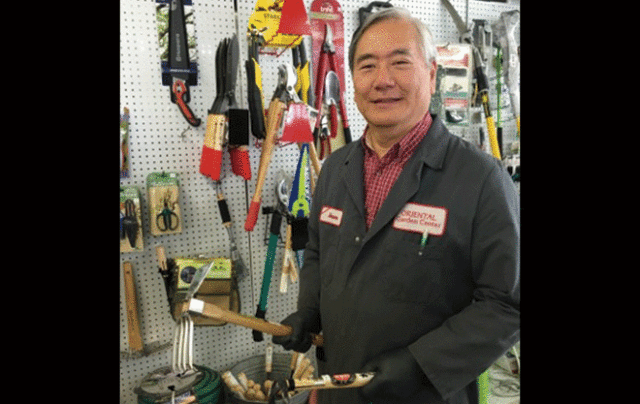By David Yamaguchi
The North American Post
Man working in yard,
No woman watching nearby;
Is the man still wrong?
Following the theme of the haiku, today we visit a specialty gardening store in Federal Way. Having started as a Nisei business in 1960, the Oriental Garden Center came up as a topic for this scribe to check out through the monthly bonsai classes they have listed on the calendar page. The center is on Pacific Highway South (Highway 99) 15 minutes south of SeaTac airport.
On meeting current owner David Asaha r a and h is wi fe, Ba rba r a Mizoguchi-Asahara, I had one question: What do they have that would draw Nik kei readers f rom Seat tle? The quest ion is apt given the intense competition in the field from big-box stores. We settled quickly on three things.
First, like many small businesses, the Oriental Garden Center offers services that the big stores do not. Their main one is small-machine repair. These days, there are fewer and fewer places that repair mowers, weed-eaters and the like. It is becoming a lost art.
Second, Mr. Asahara is a dealer for several key brands of gardening power tools. These include Husqvarna, Honda, Shindaiwa and Echo.
Third, Mr. Asahara carries Japanese gardening tools. He showed me a combined hoe and weeding tool and the sharp tiny hoe that I recognized as a “negirigama.” I knew the latter because it has become the favorite tool of Northwest geologists for smoothing muddy coastal r iverbanks before photographing their tsunami-laid sand layers. The geologists learned about negirigama from Japanese colleagues. I had not known that they came in left-and right-handed models, however.

Photos by Gwen Shigihara and David
Yamaguchi
Another draw are Okatsune pruning shears, which are known as “the sewing scissors” of shrub shears. I found it amusing that the opposing handles are painted red and white. For red was the color of the Heike and white that of the Genji as in the great AD 1185 sea-battle of Dan-no-Ura that decided who would rule Japan.
Back to the present, I took advantage of the opportunity to test Mr. Asahara’s repair knowledge by producing two dead “Husky” weed-eaters from my basement with broken starter-cord mechanisms. I had learned that Asahara is a Husqvarna dealer from the Internet before my visit.
Mr. Asahara explained that men (of a certain age) tend to break the delicate part because, out of habit, we pull the cords too hard, a practice we learned from older machines. He could order me simpler mechanisms that would last longer that I could install myself.
I was sold. Four days later, I received a call saying that my parts were in.
Wife Barbara advises “bringing in repairs sooner rather than later… In the spring and fall, David gets swamped…”
Busines s a side, M r. A saha r a explained that his father, Joe, had started gardening as a way “to escape the farm” that his Issei grandfather ran in Sumner. The father and his brother-in-law, Kenny Hikogawa, worked together as gardeners and complemented each other because the father was a “get-it-done and move on” guy, while Uncle Kenny was “a Japanese perfectionist.”
The store is an outgrowth of the men’s experience as gardeners. They saw it as a means for providing “a steady income” to support their families, according the store’s website. Yet it was interesting to hear son David’s perspective on it.
“Dad did pretty well as a gardener. He and Uncle Kenny together made $70 an hour in the 1960s. When they later opened the store, we starved…”
Speaking more broadly, Mr. Asahara said that, in the view of his father, Nisei gardeners did much to help Caucasians accept Japanese Americans after World War II. It is because the gardeners were “out there” interacting on a daily basis with the populace, instead of working within the Japanese community.




